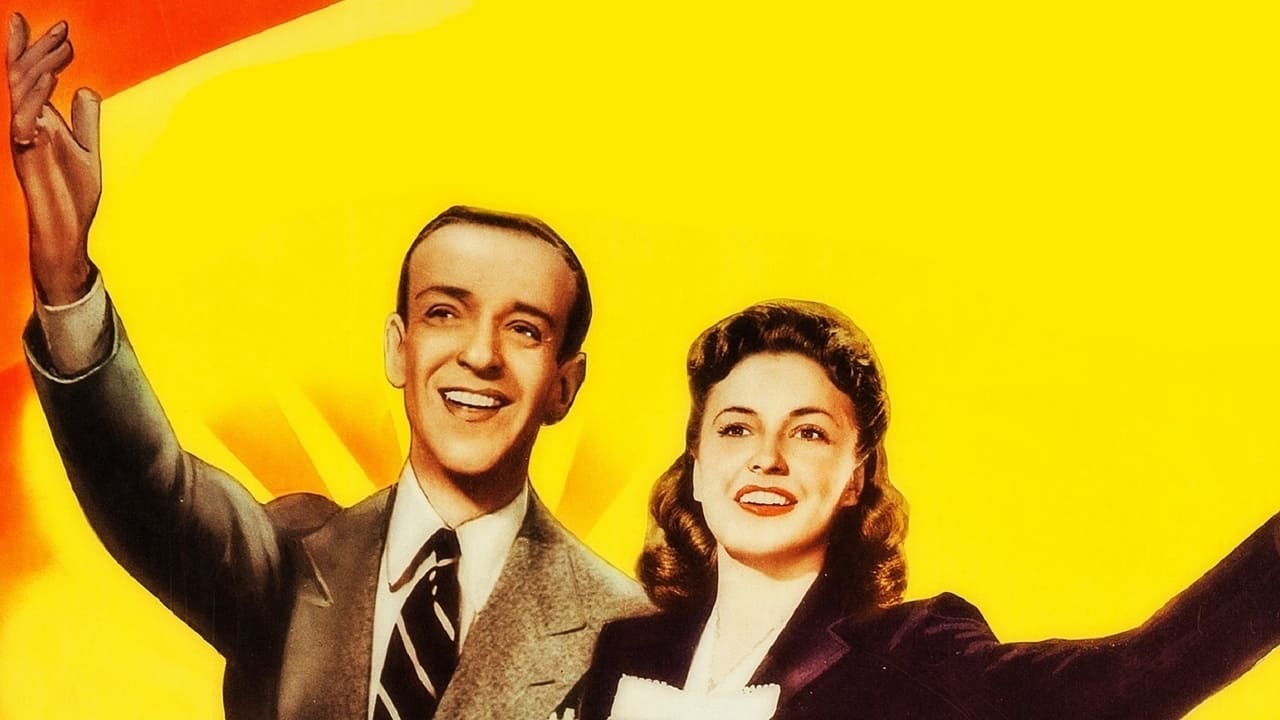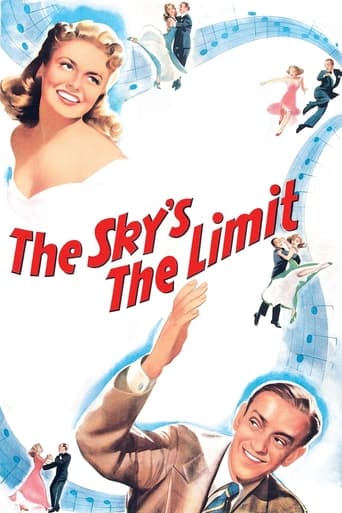

The Sky's the Limit is often deemed as one of Fred Astaire's weakest films, and it is easy to see why that is so. For me, while The Sky's the Limit is not on par with Astaire's best work, it is better than it is given credit for.Where The Sky's the Limit particularly falls down is in the story. Granted it is not a strong point in almost all of Astaire's films either, even his best work, and, while it is not as bad an instance as with Second Chorus, The Belle of New York and Let's Dance, structurally it is so flimsy that it's like there isn't any, some of the plotting is clumsily done and comes over as oddly hokey rather than believable and while the film is breezily paced and charming on the whole there are some tedious spots like the rather routine opening scene and Robert Benchley's amusing but overlong and ground-the-film-to-a-halt speech. A better use could have been made of the supporting cast too, the best coming from an amusing (though his style of humour is an acquired taste) and seemingly-dopey-but-actually-pretty-sharp-minded Robert Benchley and an expressive Elizabeth Patterson. Eric Blore is decent in the kind of role that suited him well, but it is little more than a cameo and considering the amount of talent Blore had and his knack from stealing scenes (as he showed in his appearances in the Astaire and Ginger Rogers films) didn't do enough to show off this talent. Robert Ryan also takes the film and his character too seriously, his brooding, intense persona and stiff character jarring with the general light-hearted feel of the story, with the sole exception of the snake dance scene.On the other hand, The Sky's the Limit has elegant production values and is beautifully photographed and directed with grace and assurance by Edward H. Griffith. The score is whimsical and vibrant without sounding too sentimental, and while one does wish there were more songs and that they were spaced out better the songs are very well written and work well within the film, the melodically sublime and moving My Shining Hour (also Oscar-nominated) faring the most strongly. Joan Leslie acquits herself beautifully in her solo version, but it was the duet version between her and Astaire that came off particularly well, you can really feel the love and charm between the two of them. The choreography is elegant and energetic, as well as impeccably danced, Astaire's One for my Baby, while not quite one of his greatest ever routines, is one of his bravest and most entertainment dances from his lesser films. His and Leslie's duet together is. There is also some very funny writing in The Sky's the Limit, with dialogue that sparkles with wit, even poking fun at Astaire's legendary status (have to admire how they managed to cram in a reference to Ginger Rogers). And as much criticised and how flawed the story is, it's still mostly breezily paced and has a good deal of charm. Along with the songs and the choreography, the two leads make The Sky's the Limit worth watching. Astaire's more-dramatic-than-usual character easily could have been as insufferable as his in Second Chorus, but he is immensely likable with the writing playing to his strengths as a performer, and he dances up a dream as always. Leslie may not be Ginger Rogers (which is rather unfair to her), but is an enchanting and very worthy partner for Astaire (has to be one of his most underrated too), with sparkling eyes and a radiant smile, her dancing surprisingly graceful, her acting compassionate and witty and her singing more than listenable.All in all, rather ordinary and towards the lower end of Astaire's filmography in personal ranking, but it is not that bad has a number of good merits. 6/10 Bethany Cox
... View MoreThis is a film that I saw for the first time today on TCM, and I am glad that I saw it. Knowing TCM, it will be some time before I have another opportunity. But it also will be some time before I am interested in seeing it again. Other commentators have commented on the film's strong points: some nice sets, great music, Benchley's befuddled speech and Astaire's "One for My Baby" song-and-dance routine.While I am a huge fan of Ginger Rogers, I was impressed by Joan Leslie's all-round performance as Astaire's co-star. She was apparently an extremely versatile talent - remember this is Gary Cooper's girlfriend in Sergeant York! The script placed some rather heavy demands on her character, and she delivers on all counts. It is difficult to portray a character walking the emotional tightrope of falling in love with somebody who apparently has values that you find unacceptable. Joan Leslie handles the chore admirably, focusing on her efforts to reform Astaire.Fred's character was a bust, however - but not necessarily because of his acting. He is poorly cast as a veteran of the Flying Tigers. In his first couple of scenes, he doesn't capture with authenticity a pilot in the dire circumstances that beset those beleaguered, heroic volunteers. Later he jumps off a train, abandoning a military good- will tour to pursue a good time on his own. Though less than noble, his actions are understandable. In short order, he ends up in New York, meets Joan, and begins to woo her. And that is when the movie starts to break down. As one commentator notes, the audience is never sure why Fred doesn't disclose his identity to Joan.His character is never portrayed with any clarity. He doesn't really seem connected to the war. The calendar he marks, seems to have no greater significance than to indicate the number of days he has left to pursue Joan. And that's where the script really betrays us. When does Fred transition from a desire to have a good time to a genuine affection (and eventually, love) for Joan? What prevents his telling her who he is? The fact that none of this is ever made clear is the downfall of an otherwise good movie.The only way I can explain Astaire's character to my own satisfaction is this: When he first meets Joan, he believes that as an aspiring photojournalist, she may shine an unwanted spotlight on him, depriving him of the freedom (and anonymity) to enjoy some time on his own, which is what motivated him to jump off the train. But that is never suggested by the film, itself. Instead he just waffles - agreeing to go on job interviews that he then sabotages, potentially placing her reputation in some jeopardy and also undermining her affections for him. These issues are really just swept under the carpet.In the middle of WWII, the movie did not settle for a "final" happy ending. Joan and Fred, finally do profess their love for each other, but Fred is on his way back into combat. So, the final shot of a tearful Joan is great: In a rush she is fulfilled, worried and hopeful. But Astaire's return is not to be taken for granted. This ending is realistic and cause for reflection, and consequently in odd juxtaposition to the rest of the film. If the entire film had captured more of the complexities personified by Joan Leslie in the last scene, it might have been a true classic. As it stands, Joan Leslie's nice performance, the songs, Astaire's amazing glass- smashing dance and Benchley's monologue are the best things about this movie.
... View MoreFred Astaire is an incognito war hero on leave in "The Sky's the Limit," also starring Joan Leslie, Robert Ryan, and Robert Benchley. Astaire is a member of "The Flying Tigers" and jumps off of a train so that he can have fun during his leave instead of making promotional appearances. At a bar, he sees magazine photographer Joan Leslie and falls for her without telling her who he is.This is a very sweet film with some good numbers, but I wanted more! Leslie and Astaire danced well together in the energetic "I've Got a Lot in Common With You," and Astaire's "One for My Baby" is a standout, both his singing and in a tricky dance number that involves breaking glasses with his feet. Apparently, he injured himself while filming. I love Astaire's singing - he's so musical and if his voice isn't great, it's lyrical.My only quibble is that Joan Leslie's voice was dubbed and yet it wasn't very good. If they were going to dub it, why didn't they dub it with somebody better? Certainly this was a perfect film to see in wartime - not only entertaining but poignant.
... View MoreVery few people have heard of it, but this is really one of my favorite Fred Astaire movies. In part because Fred does one of the best angry dance scenes that I've ever seen. He stumbles drunken, singing One More for my Baby, and smashes glass with his feet. He sways to the rhythm and leaps up on the metal bar to tap smash shattering glass. If you're lucky enough to see this movie keep in mind, that's real glass, not sugar glass like you normally see in movies. This was during WWII and sugar was rationed. Fred and Joan Leslie have a number of lovely romantic dance scenes. The background plot of WWII provides, well, a plot. By turns funny and bittersweet, a great dance movie.
... View More